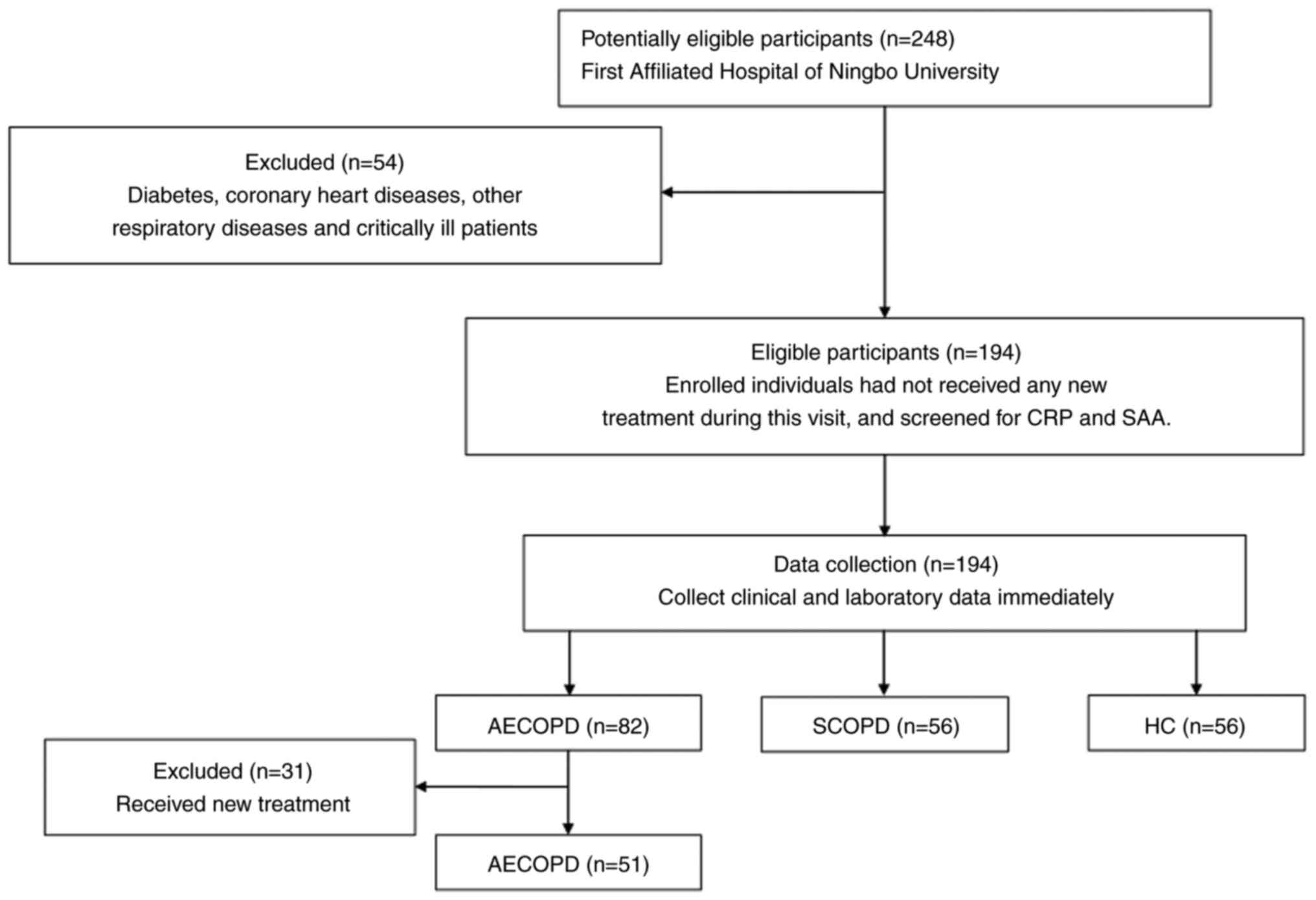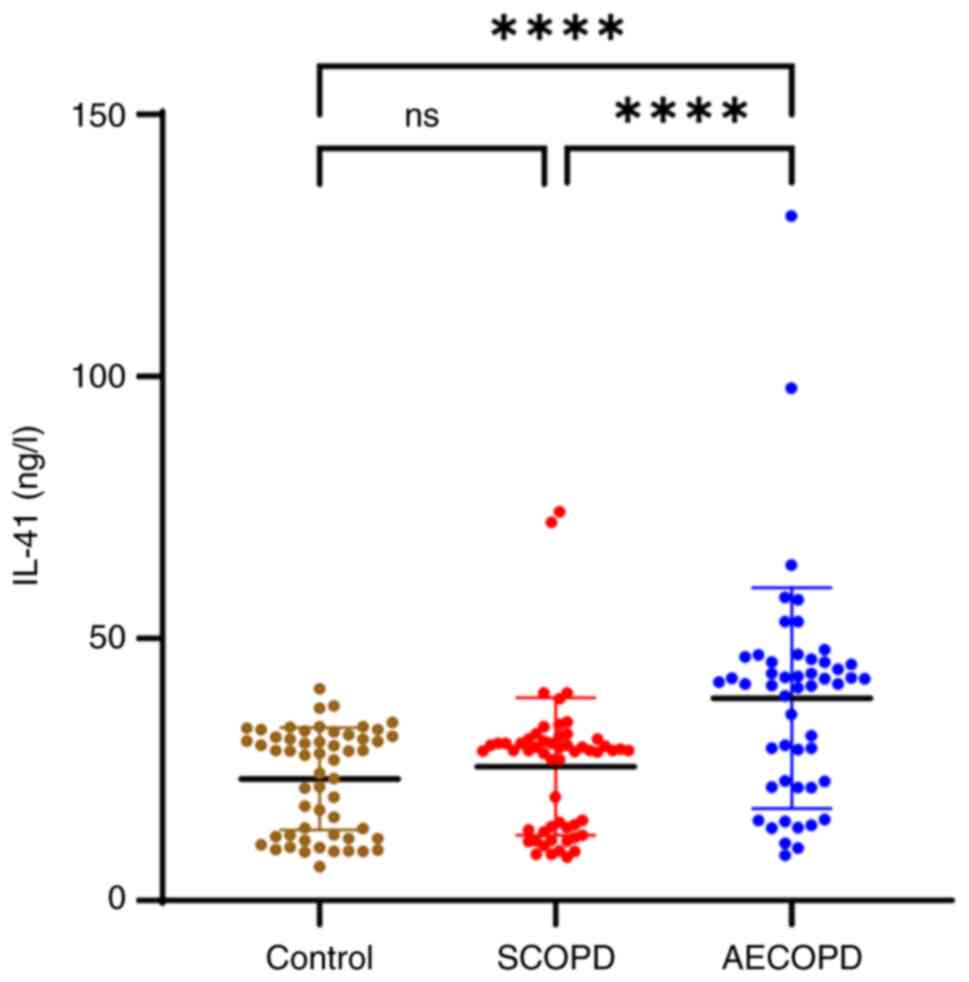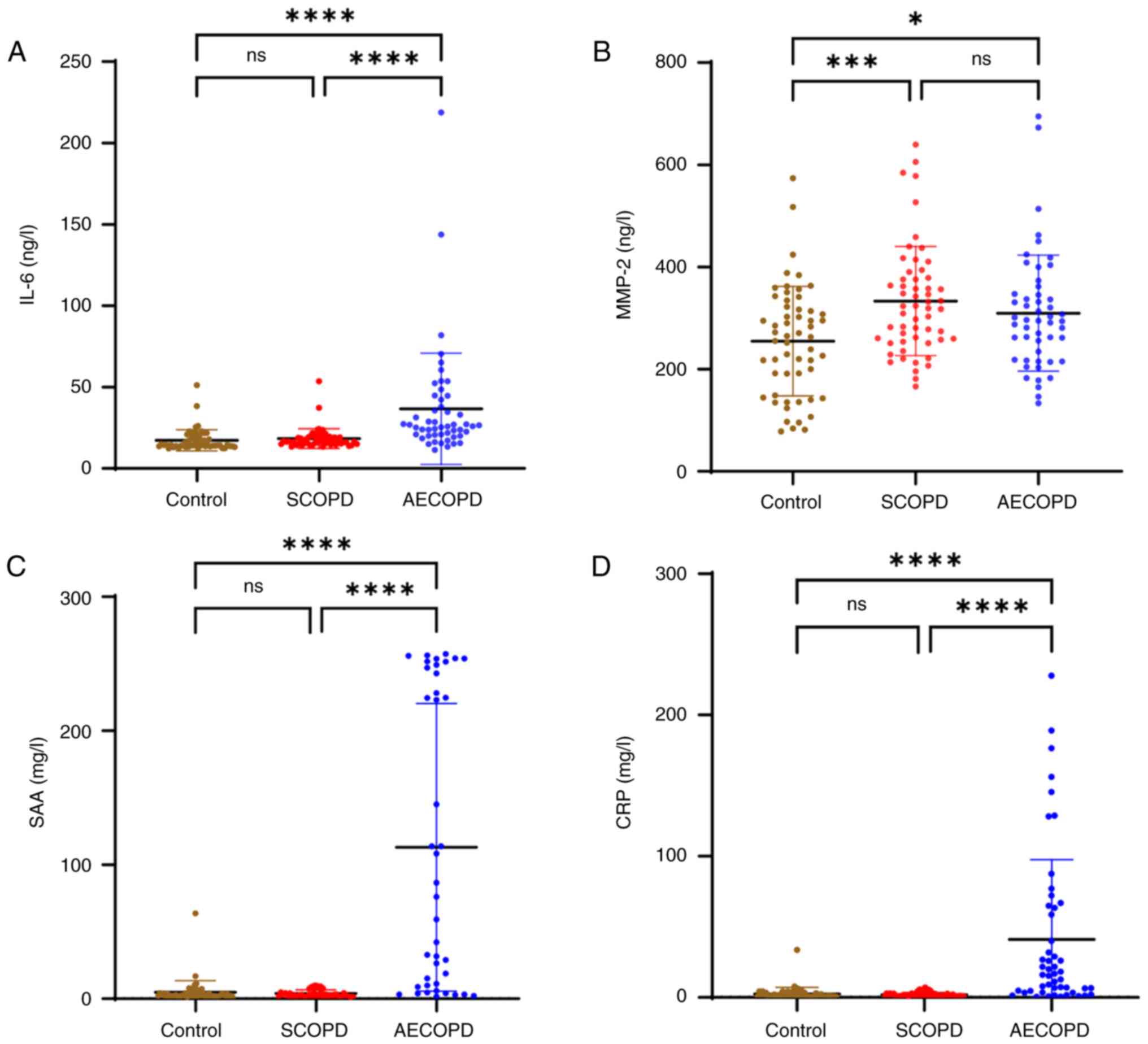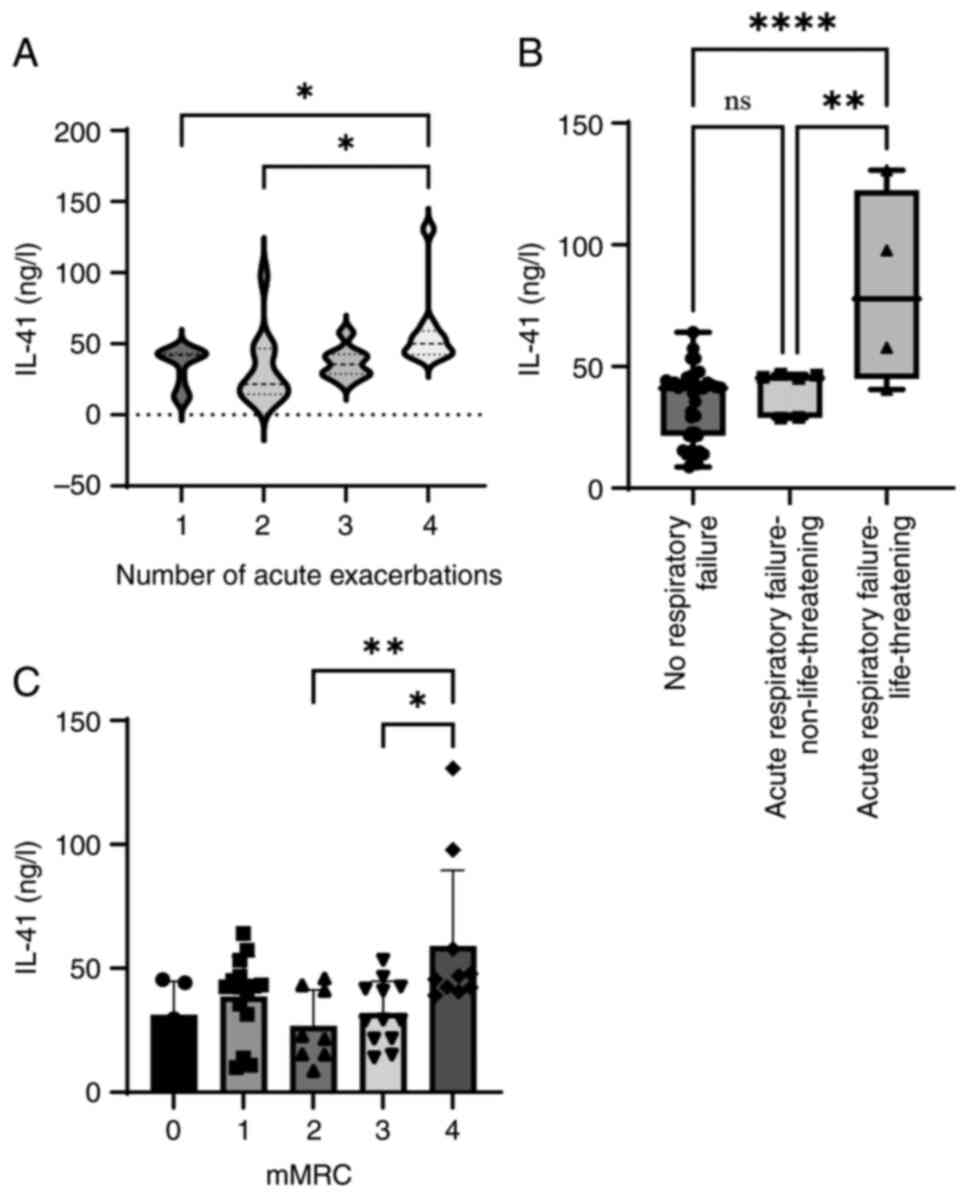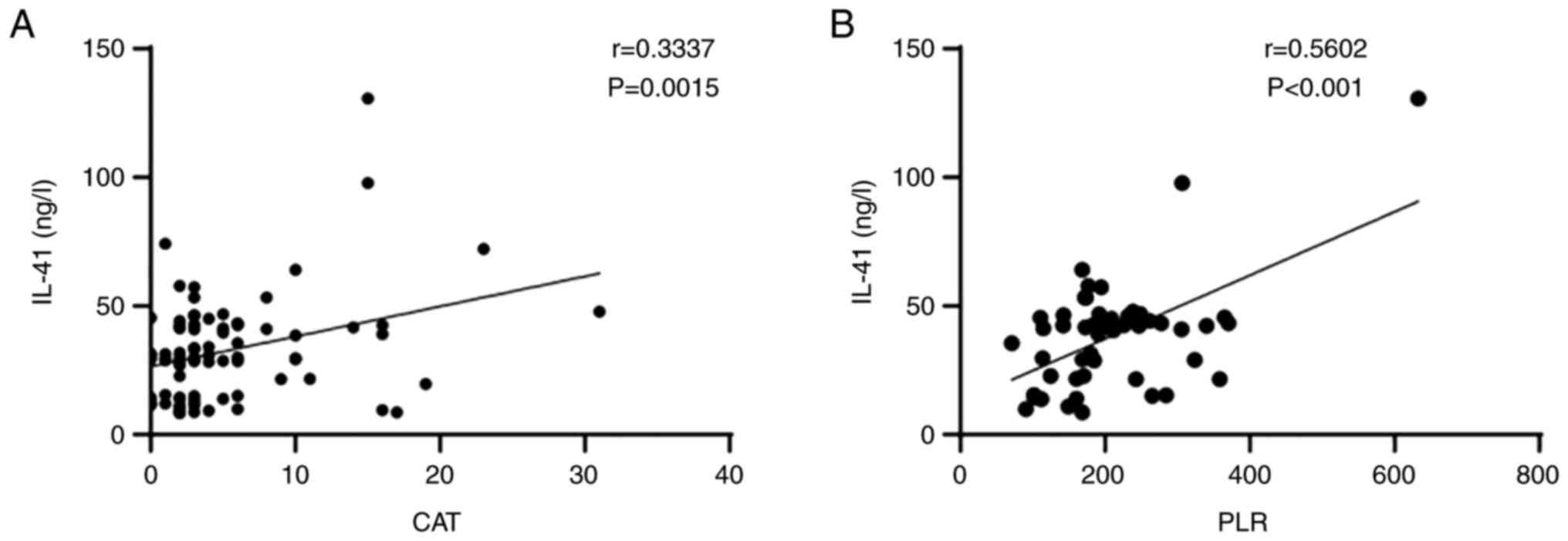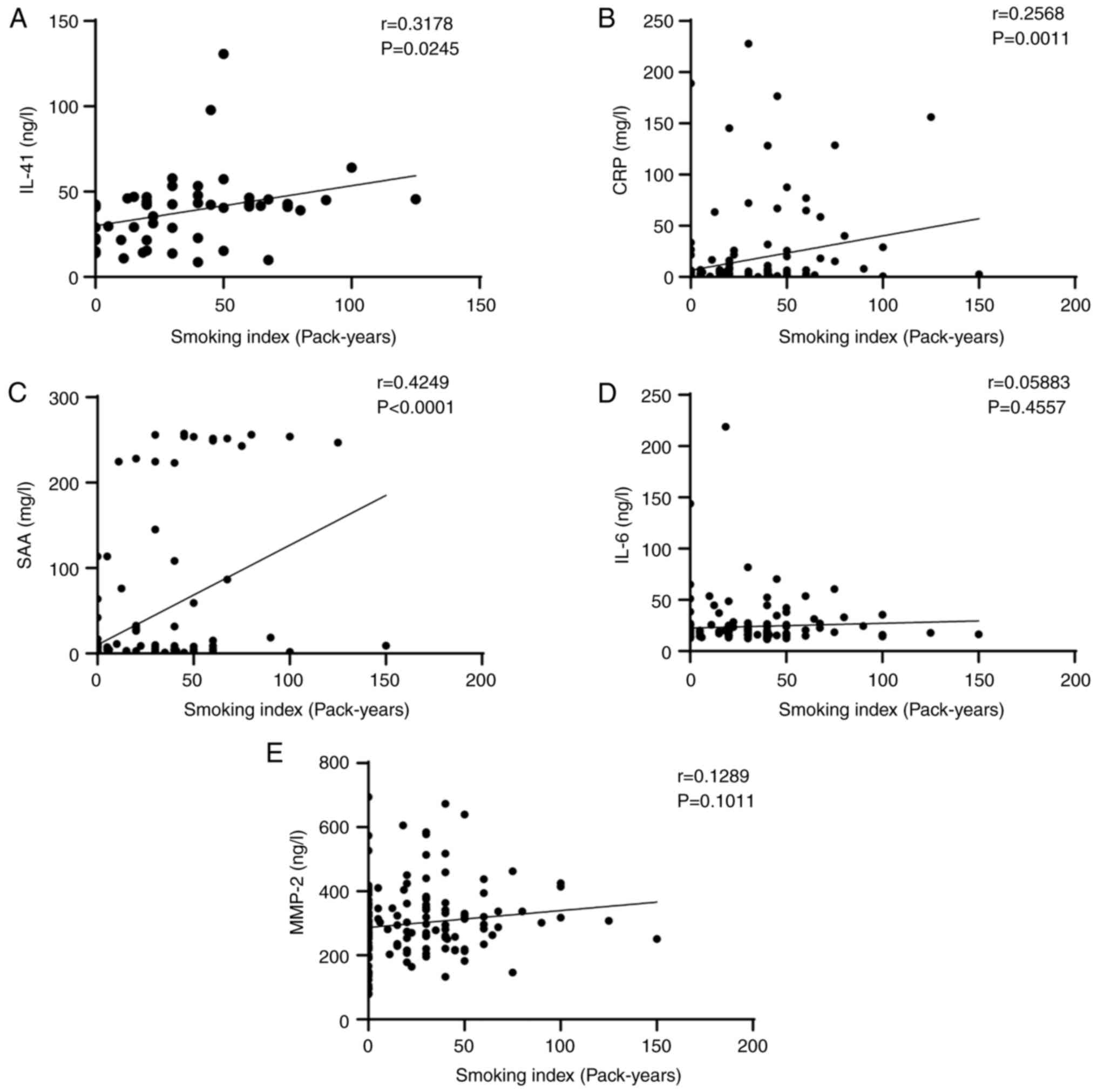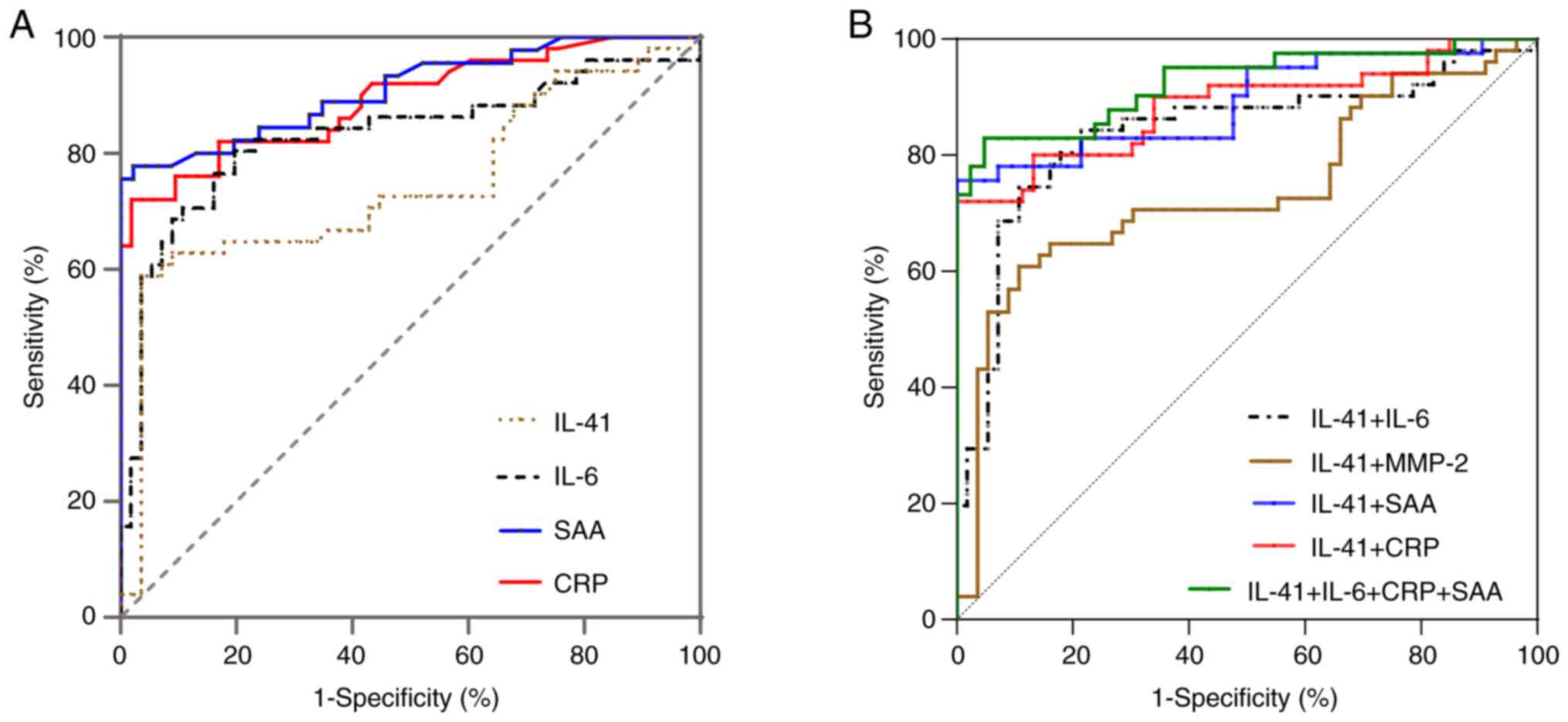Increased serum IL‑41 associated with acute exacerbation of chronic obstructive pulmonary disease
- Authors:
- Published online on: June 5, 2024 https://doi.org/10.3892/etm.2024.12601
- Article Number: 312
-
Copyright: © Cen et al. This is an open access article distributed under the terms of Creative Commons Attribution License.
Abstract
Introduction
Chronic obstructive pulmonary disease (COPD) is a heterogeneous condition characterized by chronic respiratory symptoms (dyspnea, cough and sputum production) caused by abnormalities in the airways (bronchitis and bronchiolitis) and/or alveoli (emphysema), which cause persistent, often progressive, airflow obstruction (1). Researchers have proposed adding the concept of ‘structural changes due to failed regeneration by the distal airways progenitor cells’ to the updated definition of COPD, highlighting the core traits of the disease and the demand for novel therapies (2). COPD is the most common chronic disease of the respiratory system and has a heavy economic burden. Factors contributing to the pathophysiology of COPD and leading to the degradation and regeneration of lung tissue include an imbalance in the protease and antiprotease systems, an imbalance in oxidation-antioxidant activity, and continuous airway inflammation (3).
Acute exacerbation of COPD (AECOPD) is mainly caused by infection or the inhalation of toxic gases. During acute exacerbation, the baseline symptoms of a patient, such as cough, expectoration, wheezing and dyspnea, deteriorate significantly. AECOPD is the leading cause of patient consultation and hospitalization. This hospitalization can lead to further decline in lung function, seriously affecting the quality of life of the patient, and shortening their life expectancy. Frequent hospitalization for COPD exacerbations has also been associated with higher mortality risk (4). Mortality in patients with severe AECOPD exceeds 20% within 1 year and 50% within 5 years (5). Compared with stable COPD (SCOPD), airway and systemic inflammation in AECOPD is further increased, and inflammatory mediators, cytokines and chemokines are released, causing inflammatory cells to enter the lung parenchyma and resulting in systemic inflammatory responses. Scholars worldwide are committed to identifying additional specific biomarkers in the blood to evaluate the disease, and have found that certain biomarkers have specific reference values for evaluating COPD.
Interleukin (IL)-41, a novel cytokine with immunoregulatory properties (6) often linked to anti-inflammatory effects, is also known as meteorin-like, glial cell differentiation regulator (Metrnl), cometin, subfatin, meteorin and IL-39(7). IL-41 mediates both pro-inflammatory and anti-inflammatory functions (8). The immune response is diminished when the production of IL-41 by M2 macrophages is blocked. IL-41 mutant mice experienced a more severe inflammatory injury in the liver, kidney, and particularly the uterus when injected with adenoviral vectors expressing LacZ or Metrnl (9). This implies that IL-41 is crucial for maintaining anti-inflammatory balance. In a clinical trial, increased inflammation and macrophage activity were primarily responsible for high IL-41 levels observed in smokers with AECOPD (10). However, compared with the general population, individuals who were discharged after an acute exacerbation had lower plasma IL-41 levels (11).
IL-6 is a cytokine with multiple functions that regulates the immune response, inflammation and tumor growth (5). Golestani et al (11) found that the concentration of IL-6 in exhaled breath condensate was markedly higher in patients with AECOPD than in those with SCOPD. The endopeptidase enzyme, matrix metalloproteinase-2 (MMP-2), separates extracellular matrix proteins (12). In patients with severe COPD, MMP-2 may facilitate processes that cause lung tissue deterioration (13). Serum amyloid A (SAA) is a precursor protein involved in AA amyloidosis and a polymorphic acute-phase protein secreted by hepatocytes that regulates innate immunity and cholesterol homeostasis (14). Prins et al (15) found that patients with AECOPD had considerably high levels of SAA. C-reactive protein (CRP) is a classic inflammatory marker for determining infection and inflammatory responses and reflects the total burden of systemic inflammation in an individual (16). Xu and Han (17) reported that CRP levels were related to the severity of AECOPD complicated by pneumonia. Another study revealed that the neutrophil percentage (NEU%), neutrophil-to-lymphocyte ratio (NLR), and platelet-to-lymphocyte ratio (PLR) in the AECOPD group were considerably higher than those in the SCOPD and healthy control groups, suggesting NEU%, NLR and PLR may have specific values for the clinical diagnosis and treatment of AECOPD (18). The aim of the present study was to explore the correlation between IL-41 and AECOPD.
Patients and methods
Study design
Patients with COPD and healthy controls were enrolled at the First Affiliated Hospital of Ningbo University (Ningbo, China) between March 2021 and November 2022. Among them, 51 patients (AECOPD group) and 56 (SCOPD group) were enrolled. A total of 56 healthy individuals who visited the hospital for an in-person checkup during the same period were selected as the healthy control group at the same time. The average age of the AECOPD group was (72.16±10.13) years, the average age of the SCOPD group was (69.32±10.06) years and the average age of the healthy control group was (70.07±6.12) years. The male/female ratio was 50/1 in the AECOPD group, 49/7 in the SCOPD group and 50/6 in the healthy control group. There were no significant differences in terms of gender and age among the three groups (P<0.05).
All individuals with COPD met the Global Initiative for Chronic Obstructive Lung Disease (GOLD) diagnostic criteria (19): i) The patient exhibited symptoms such as long-term recurrent cough, expectoration and dyspnea; ii) previous exposure to cigarette smoke and dust; and iii) pulmonary function test results showing a forced expiratory volume (FEV1)/forced vital capacity (FVC) ratio <70% after bronchodilator inhalation. Patients with other diseases that could cause similar symptoms and persistent airflow limitation were excluded.
An event that meets the diagnostic criteria for AECOPD was defined as one that worsens in <14 days; is characterized by increased dyspnea, cough and sputum; and may be accompanied by tachypnea and/or tachycardia. Such an event is frequently associated with increased local and systemic inflammation caused by infection, pollution, or other insults to the airways (20). The diagnostic criteria for SCOPD were as follows: Stable symptoms such as cough, expectoration and shortness of breath, or stable symptoms 1 month after an AECOPD event.
The exclusion criteria were as follows: i) Patients with bronchial asthma, bronchiectasis, interstitial lung disease, lung cancer or tuberculosis; ii) patients with severe immune system, brain, kidney, heart or blood diseases; and iii) other diseases that could cause elevated SAA, CRP, IL-6 and MMP-2 levels. As IL-41 is related to diabetes and coronary heart disease, patients with these conditions were excluded. The screening procedure is depicted in Fig. 1.
The Ethics Committee of the First Affiliated Hospital of Ningbo University (Ningbo, China) granted consent for the present study (approval no. 088RS-YJ01), and written informed consent was obtained from all participants. The study was conducted in accordance with the tenets put forth in the Declaration of Helsinki of 1964 and any subsequent modifications.
For pulmonary function testing: i) The participants sat during the examination, and pulmonary function tests were performed using a pulmonary function instrument (Portable pulmonary function testing instrument, X1; Xiamen XEEK Medical Equipment Co., Ltd.); ii) FVC, FEV1, FEV1/FVC (%) and FEV1% were recorded before and after administration of the tracheal dilator (albuterol, 400 µg) three times with an interval of 3 min, and the three results were averaged; iii) To reduce the influence of human factors, examinations were performed by the same professional, and the same pulmonary function instrument was used (calibration was required before each examination). Lung function in patients with acute exacerbations was measured 1 month after their condition had stabilized.
AECOPD blood samples were obtained at the time of admission, before antibiotics, hormones and other drugs were used. The drugs used in the SCOPD group were mainly inhaled drugs and oral expectorant drugs, and there was no study identified showing that these inhaled drugs and oral expectorant drugs cause the increase of CRP, SAA, IL-41 and MMP-2. IL-6 and MMP-2 levels were measured using enzyme-linked immunosorbent assay (ELISA) kits (cat. nos. KP00139 and KP00077, respectively; Wuhan Sanying Biotechnology) according to the manufacturer's instructions. IL-41 levels in serum were also measured using ELISA kits (cat. no. LV11160; Animalunion Biotechnology Co., Ltd) following the manufacturer's instructions. Serum CRP levels were assessed in a hospital laboratory using automated latex-enhanced immunoturbidimetric assays (cat. no. 105-004860-00; Shenzhen Mindray Biomedical Electronics Co., Ltd.), and mouse monoclonal anti-CRP antibody at a concentration of 1.4 mg/ml bound latex was included in the kit. Serum SAA levels were assessed in a hospital laboratory using the automated latex immunoturbidimetric assay [at. no. 8240-717(S); Ningbo Ruiyuan Biotechnology Co., Ltd.], and the kit contained appropriate concentrations of latex particles coated with mouse anti-human serum amyloid A antibody.
Statistical analysis
GraphPad Prism (version 9; Dotmatics), SPSS (version 25; IBM Corp.), and MedCalc (version 22.009; MedCalc Software) were used for the data analysis, statistical analysis and plotting, respectively. Data are presented as the mean ± standard deviation (SD). Differences in continuous data between groups were compared using Student's t-test or the Mann-Whitney U-test, and the χ2-test was used for comparisons of categorical data. One-way analysis of variance was used to compare differences between multiple groups, and an independent samples t-test was used to compare differences between two groups. The post-hoc test used with ANOVA was Turkey's test. Pearson's correlation coefficient was used to analyze data conforming to a normal distribution. Spearman's rank correlation coefficient was used to analyze data that did not conform to a normal distribution. ROC curve analysis was used to examine the diagnostic value. P<0.05 was considered to indicate a statistically significant difference.
Results
Study population
The present study included 107 patients with a confirmed COPD diagnosis. There were 51 patients diagnosed with AECOPD and 56 diagnosed with SCOPD. A total of 56 healthy controls who visited the hospital for in-person checkups during the recruitment period were also included in the analysis. There were no significant differences in sex, age or body mass index among the three groups (P>0.05). The baseline data of the patients are presented in Table I.
Concentrations of IL-41 and other inflammatory factors in serum
IL-41, IL-6, SAA, and CRP levels were higher in the AECOPD group than those in the SCOPD and control groups (P<0.0001). The NEU%, NLR and PLR were also higher in the AECOPD group than in the SCOPD and control groups (P<0.05; Table I). Although the levels of IL-41, IL-6, SAA and CRP were higher in the SCOPD group than those in the control group, the differences were not statistically significant (Figs. 2 and 3). The levels of MMP-2 were lower in the control group than those in the SCOPD (P<0.001) and AECOPD groups (P<0.05) (Fig. 3). There was no significant difference in the level of MMP-2 between the AECOPD and SCOPD groups (Fig. 3).
Correlation of the expression level of IL-41 with the number of acute exacerbations, severity of the exacerbation, PLR, smoking index, modified (British) Medical Research Council (mMRC) scores and COPD assessment test (CAT) scores
Only patients in the AECOPD group were included in the correlation analysis. ‘Number of acute exacerbations’ refers to the number of exacerbations in the past year. The degree of exacerbation in hospitalized patients was determined according to the clinical indicators of the patient as described in the 2023 GOLD report, which suggests three groups: No respiratory failure; acute respiratory failure, non-life-threatening; and acute respiratory failure, life-threatening (21).
With increased COPD severity, an overall increasing trend in the serum level of IL-41 was observed (Fig. 4). The correlations between the expression level of IL-41 and other factors were also analyzed. It was determined that the serum level of IL-41 was positively correlated with PLR (r=0.5602, P<0.001) and CAT score (r=0.3337, P<0.0015) in the AECOPD group (Fig. 5). It was also found that smoking index was positively correlated with serum IL-41 (r=0.3178, P=0.0245), CRP (r=0.2568, P=0.0011), and SAA (r=0.4249, P<0.0001) levels. However, smoking index was not correlated with serum IL-6 (r=0.05883, P=0.4557) or MMP-2 (r=0.1289, P=0.1011) levels (Fig. 6).
In conclusion, the levels of IL-41 were associated with the severity of AECOPD, as indicated by the correlation between IL-41 and the number of acute exacerbations, severity of exacerbation, and CAT scores in the AECOPD group.
Diagnostic values of IL-41
In the included population, with a cutoff of 40.10 ng/l, the AUC, sensitivity and specificity of IL-41 to discriminate between AECOPD and SCOPD cases were 0.741 (95% confidence interval, 0.642-0.841; P<0.001), 58.82, and 96.43%, respectively (Fig. 7 and Table II).
There were significant differences in the AUC between IL-41 and IL-41 combined with IL-6 [0.839 (0.757-0.922), z=1.863, P=0.0625], IL-41 combined with SAA [0.891 (0.818-0.964), z=2.994, P=0.0028], IL-41 combined with CRP [0.881 (0.805-0.957), z=2.891, P=0.0038], and IL-41 combined with these three inflammatory factors [0.925 (0.865-0.984), z=3.493, P=0.0005]. There was a significant difference in the AUC between IL-41 combined with IL-6, and IL-41 combined with the three inflammatory factors [0.925 (0.865-0.984), z=2.812, P=0.0049] (Tables II and III).
Discussion
The World Health Organization has estimated that 65 million individuals worldwide have mild-to-severe COPD, and its prevalence is increasing (22). In severe cases, admission to an intensive care center with passive or mechanical ventilation is necessary, resulting in considerable medical and economic burdens. Moreover, the diagnosis of COPD is subjective. Therefore, it is important to identify the biomarkers associated with AECOPD. There are two types of biomarkers for AECOPD: Pulmonary and systemic. Pulmonary biomarkers include IL-6, IL-8 and myeloperoxidase (23). Systemic biomarkers include CRP, procalcitonin, NLR and platelet distribution width values (24). However, no single biomarker has been widely used.
A previous study by Xu et al (25) also found that the FEV1, FEV1/FVC, and serum CRP, IL-6 and tumor necrosis factor (TNF)-α levels of patients with COPD in the smoking group were significantly lower than those of patients with COPD in the non-smoking group. The levels of CD+4 and CD+4/CD+8 were also significantly lower in smokers than those in non-smokers. It has been suggested that smoking may lead to impaired lung function in patients with COPD, which may subsequently aggravate airway inflammation and weaken T-lymphocyte immune function. Xian and Chen (26) found that FEV1 and diffusing capacity for carbon monoxide (DLCO%) of patients with AECOPD in the smoking group were significantly lower than those of patients with AECOPD in the non-smoking group and healthy controls. Furthermore, it was also revealed that the expression levels of serum cytokines such as procalcitonin, CRP, IL-6 and TNF-α were significantly higher in the smoking group than in the non-smoking and control groups. These findings indicate that the smoking status of patients with AECOPD is an important indicator of the expression of inflammatory factors. The findings in the present study revealed that the smoking index was positively correlated with serum IL-41, CRP and SAA levels.
IL-41 production is blocked in M2 macrophages, which reduces the immunological response. Numerous studies on the mechanism of action of macrophages in COPD have been published, drawing attention to the significance of macrophage polarization in the disease. ‘Macrophage polarization’ describes the geographical and temporal patterns of macrophage activation (27). In response to the synthesis of several signaling molecules and inflammatory factors, both conventionally activated (M1) and alternatively activated (M2) macrophage polarization is possible, demonstrating their high plasticity. In the lungs, M2 macrophages suppress inflammatory responses, whereas M1 macrophages promote them (28). By controlling macrophage polarization, IL-41 may contribute to the pulmonary inflammation associated with COPD; however, its specific role and mechanism require further study.
The findings of the present study indicate that, although IL-41 levels did not differ between the SCOPD and control groups, the IL-41 level was higher in the AECOPD group than those in the SCOPD and control groups. IL-6, SAA, CRP, NEU%, NLR and PLR values were higher in the AECOPD group than those in the SCOPD and control groups. IL-41 levels were also correlated with AECOPD severity. Compared with common inflammatory factors such as IL-6, CRP and SAA, IL-41 did not exhibit obvious superiority in diagnostic efficacy, but it did have high specificity. Use of a combination of factors significantly improved the efficiency of AECOPD diagnosis. A previous study by the authors also revealed that IL-41, which suppresses cigarette smoke-induced pulmonary inflammation in vivo in mice, can be used therapeutically to treat inflammatory lung conditions (29). According to earlier investigations, IL-41 level has been linked to diabetes and coronary heart disease, and the plasma IL-41 level in patients with AECOPD with diabetes mellitus and coronary heart disease was found to be lower than that in patients with AECOPD without diabetes and coronary heart disease (9). This implies that, during the acute phase, patients with AECOPD with diabetes and coronary heart disease do not generate a strong anti-inflammatory response. Therefore, we hypothesized that IL-41 level is elevated in patients with AECOPD and associated with AECOPD. IL-41 may inhibit inflammation by promoting macrophage polarization in the M2 direction and upregulate gene expression of M2 macrophages and their markers via a signal transduction pathway.
The present study did have some limitations. First, patients with diabetes or coronary heart disease were excluded. Second, the number of participants in this study was relatively limited, and the included population was predominantly male, indicating the study may have been affected by selection bias. The role of IL-41 in the pathophysiology of COPD requires further studies with larger sample sizes. The correlation between IL-41 level and sex also requires further exploration. Third, due to ethical reasons, it was very difficult to obtain tracheoscopic or ventilator secretions from COPD patients and analyze the correlation with the serum level of IL-41. The relationship between tracheoscopic or ventilator secretions from patients with COPD and the serum level of IL-41 may be addressed in a future study.
In conclusion, the expression level of IL-41 was increased in the serum of patients with AECOPD, indicating it may play a significant role in the inflammatory process of COPD and, especially, AECOPD. In the future, IL-41 may be a useful biomarker for the monitoring, evaluation and treatment of patients with AECOPD.
Acknowledgements
Not applicable.
Funding
Funding: This work was supported by the Natural Science Foundation of Ningbo (grant nos. 2021J242 and 2021J080) and the Key Research and Development Plan of Ningbo city (grant no. 2023Z179).
Availability of data and materials
The data generated in the present study may be requested from the corresponding author.
Authors' contributions
TC, MH and HM designed the study, wrote the manuscript. MH, ML and JJ collected clinical information and serum of the patients. ML, JJ, QD and DL designed and performed the statistical analysis. LF and SW performed the experiments. HM revised the manuscript (for intellectual content) and gave final approval for publication. TC, HM, JJ, ML, QD, DL, LF, SW and HM confirmed the authenticity of all the raw data. All authors have read and approved the final manuscript.
Ethics approval and consent to participate
The Ethics Committee of the First Affiliated Hospital of Ningbo University (Ningbo, China) granted consent for the present study (approval no. 088RS-YJ01), and written informed consent was obtained from all participants. It is attested that the study was carried out considering the Declaration of Helsinki of 1964 and any subsequent changes.
Patient consent for publication
Not applicable.
Competing interests
The authors declare that they have no competing interests.
References
|
Celli B, Fabbri L, Criner G, Martinez FJ, Mannino D, Vogelmeier C, Montes de Oca M, Papi A, Sin DD, Han MK and Agusti A: Definition and nomenclature of chronic obstructive pulmonary disease: Time for its revision. Am J Respir Crit Care Med. 206:1317–1325. 2022.PubMed/NCBI View Article : Google Scholar | |
|
Confalonieri M, Braga L, Salton F, Ruaro B and Confalonieri P: Chronic obstructive pulmonary disease definition: Is it time to incorporate the concept of failure of lung regeneration? Am J Respir Crit Care Med. 207:366–367. 2023.PubMed/NCBI View Article : Google Scholar | |
|
Christenson SA, Smith BM, Bafadhel M and Putcha N: Chronic obstructive pulmonary disease. Lancet. 399:2227–2242. 2022.PubMed/NCBI View Article : Google Scholar | |
|
Perera WR, Hurst JR, Wilkinson TM, Sapsford RJ, Müllerova H, Donaldson GC and Wedzicha JA: Inflammatory changes, recovery and recurrence at COPD exacerbation. Eur Respir J. 29:527–534. 2007.PubMed/NCBI View Article : Google Scholar | |
|
Wei Y, Wang S, Wang D and Liu C: Expression and clinical significance of serum amyloid A and interleukin-6 in patients with acute exacerbation of chronic obstructive pulmonary disease. Exp Ther Med. 19:2089–2094. 2020.PubMed/NCBI View Article : Google Scholar | |
|
Bridgewood C, Russell T, Weedon H, Baboolal T, Watad A, Sharif K, Cuthbert R, Wittmann M, Wechalekar M and McGonagle D: The novel cytokine Metrnl/IL-41 is elevated in Psoriatic Arthritis synovium and inducible from both entheseal and synovial fibroblasts. Clin Immunol. 208(108253)2019.PubMed/NCBI View Article : Google Scholar | |
|
Zheng SL, Li ZY, Song J, Liu JM and Miao CY: Metrnl: A secreted protein with new emerging functions. Acta Pharmacol Sin. 37:571–579. 2016.PubMed/NCBI View Article : Google Scholar | |
|
Ushach I, Arrevillaga-Boni G, Heller GN, Pone E, Hernandez-Ruiz M, Catalan-Dibene J, Hevezi P and Zlotnik A: Meteorin-like/Meteorin-β is a novel immunoregulatory cytokine associated with inflammation. J Immunol. 201:3669–3676. 2018.PubMed/NCBI View Article : Google Scholar | |
|
Rao RR, Long JZ, White JP, Svensson KJ, Lou J, Lokurkar I, Jedrychowski MP, Ruas JL, Wrann CD, Lo JC, et al: Meteorin-like is a hormone that regulates immune-adipose interactions to increase beige fat thermogenesis. Cell. 157:1279–1291. 2014.PubMed/NCBI View Article : Google Scholar | |
|
Kerget B, Afşin DE, Kerget F, Aşkın S and Akgün M: Is metrnl an adipokine involved in the anti-inflammatory response to acute exacerbations of COPD? Lung. 198:307–314. 2020.PubMed/NCBI View Article : Google Scholar | |
|
Golestani R, Razavian M, Ye Y, Zhang J, Jung JJ, Toczek J, Gona K, Kim HY, Elias JA, Lee CG, et al: Matrix metalloproteinase-targeted imaging of lung inflammation and remodeling. J Nucl Med. 58:138–143. 2017.PubMed/NCBI View Article : Google Scholar | |
|
Alrumaihi F: A cheminformatics-biophysics correlate to identify promising lead molecules against matrix metalloproteinase-2 (MMP-2) enzyme: A promising anti-cancer target. Saudi Pharm J. 31:1244–1253. 2023.PubMed/NCBI View Article : Google Scholar | |
|
Zhang Y, Li Y, Ye Z and Ma H: Expression of matrix metalloproteinase-2, matrix metalloproteinase-9, tissue inhibitor of metalloproteinase-1, and changes in alveolar septa in patients with chronic obstructive pulmonary disease. Med Sci Monit. 26(e925278)2020.PubMed/NCBI View Article : Google Scholar | |
|
Tanaka M, Takarada T, Nadanaka S, Kojima R, Hosoi K, Machiba Y, Kitagawa H and Yamada T: Influences of amino-terminal modifications on amyloid fibril formation of human serum amyloid A. Arch Biochem Biophys. 742(109615)2023.PubMed/NCBI View Article : Google Scholar | |
|
Prins HJ, Duijkers R, Kramer G, Boerhout E, Rietema FJ, de Jong PA, Schoorl MI, van der Werf TS and Boersma WG: Relationship between biomarkers and findings on low-dose computed tomography in hospitalised patients with acute exacerbation of COPD. ERJ Open Res. 8:00054–2022. 2022.PubMed/NCBI View Article : Google Scholar | |
|
Tan Q, Wang B, Ye Z, Mu G, Liu W, Nie X, Yu L, Zhou M and Chen W: Cross-sectional and longitudinal relationships between ozone exposure and glucose homeostasis: Exploring the role of systemic inflammation and oxidative stress in a general Chinese urban population. Environ Pollut. 329(121711)2023.PubMed/NCBI View Article : Google Scholar | |
|
Xu B and Han L: Predictive Value of CRP, PCT and ESR on piperacillin-tazobactam in treating chronic obstructive pulmonary disease with pneumonia. Clin Lab. 69:2023.PubMed/NCBI View Article : Google Scholar | |
|
Han Fang and Bin Zhao: Donghong Liu(2020) To explore the clinical value of NLR and PLR in the treatment of acute exacerbation of chronic obstructive pulmonary disease. General practice clinical and education. 18:694–697. 2020. | |
|
Venkatesan P: GOLD COPD report: 2024 update. Lancet Respir Med. 12:15–16. 2024.PubMed/NCBI View Article : Google Scholar | |
|
Celli BR, Fabbri LM, Aaron SD, Agusti A, Brook R, Criner GJ, Franssen FME, Humbert M, Hurst JR, O'Donnell D, et al: An updated definition and severity classification of chronic obstructive pulmonary disease exacerbations: The rome proposal. Am J Respir Crit Care Med. 204:1251–1258. 2021.PubMed/NCBI View Article : Google Scholar | |
|
Agustí A, Celli BR, Criner GJ, Halpin D, Anzueto A, Barnes P, Bourbeau J, Han MK, Martinez FJ, Montes de Oca M, et al: Global initiative for chronic obstructive lung disease 2023 report: GOLD executive summary. Eur Respir J. 61(2300239)2023.PubMed/NCBI View Article : Google Scholar | |
|
Gautam SS and O'Toole RF: Convergence in the epidemiology and pathogenesis of COPD and pneumonia. COPD. 13:790–798. 2016.PubMed/NCBI View Article : Google Scholar | |
|
Koutsokera A, Kostikas K, Nicod LP and Fitting JW: Pulmonary biomarkers in COPD exacerbations: A systematic review. Respir Res. 14(111)2013.PubMed/NCBI View Article : Google Scholar | |
|
Ramya PA, Mohapatra MM, Saka VK, Kar R, Chakkalakkoombil SV and Vemuri MB: Haematological and inflammatory biomarkers among stable COPD and acute exacerbations of COPD patients. Sultan Qaboos Univ Med J. 23:239–244. 2023.PubMed/NCBI View Article : Google Scholar | |
|
Xu Haifeng, Sun Yifeng and Lin Huan: Effects of smoking on immune inflammatory response and pulmonary function in patients with chronic obstructive pulmonary disease. J Clin Pulmonol. 25:58–61. 2020. | |
|
Xian Shaojing and Chen Qingyun: Changes of lung function and serum cytokine levels in patients with acute exacerbation of chronic obstructive pulmonary disease and their correlation with smoking and body mass index. J Clin & Pathology. 42:144–150. 2021. | |
|
Murray PJ: Macrophage Polarization. Annu Rev Physiol. 79:541–566. 2017.PubMed/NCBI View Article : Google Scholar | |
|
Bazzan E, Turato G, Tinè M, Radu CM, Balestro E, Rigobello C, Biondini D, Schiavon M, Lunardi F, Baraldo S, et al: Dual polarization of human alveolar macrophages progressively increases with smoking and COPD severity. Respir Res. 18(40)2017.PubMed/NCBI View Article : Google Scholar | |
|
Cen T, Mai Y, Jin J, Huang M, Li M, Wang S and Ma H: Interleukin-41 diminishes cigarette smoke-induced lung inflammation in mice. Int Immunopharmacol. 124(Pt A)(110794)2023.PubMed/NCBI View Article : Google Scholar |



